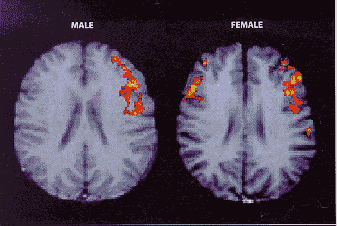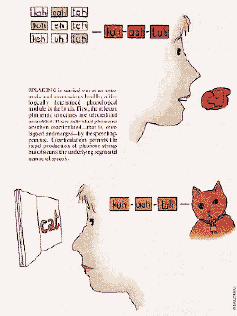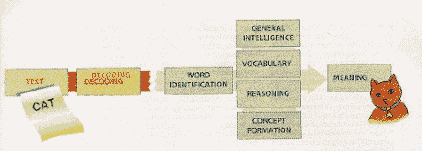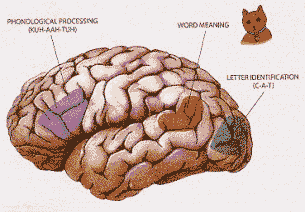10 Years of Brain Imaging Research Shows The Brain Reads Sound By Sound
 A dyslexia research team at Yale University's Center for Learning and Attention lead by Dr. Sally Shaywitz has found a window on the brain through a new imaging technique called functional MRI. These medical scientists have identified parts of the brain used in reading. By observing the flow of oxygen-rich blood to working brain cells, they have found that people who know how to sound out words can rapidly process what they see. This information has shed new light on dyslexia and how to help dyslexics.
A dyslexia research team at Yale University's Center for Learning and Attention lead by Dr. Sally Shaywitz has found a window on the brain through a new imaging technique called functional MRI. These medical scientists have identified parts of the brain used in reading. By observing the flow of oxygen-rich blood to working brain cells, they have found that people who know how to sound out words can rapidly process what they see. This information has shed new light on dyslexia and how to help dyslexics.
When readers are asked to imagine "cat" without the "kah" sound, they readily summon "at." The MRI photographs show their brains lighting up like pinball machines. When the brain gets it, the light bulbs really do go on. However, the brains of people who can't sound out words often look different on MRI pictures. There is less blood flow to the language centers of the brain and, in some cases, not much activity evident at all. Scientist's are not sure why this is or what it means. But simply put, without the ability to sound out words, the brain is stumped.
Basically this research seems to be saying that the brain learns to read the same way it learns to talk, one sound at a time. When babies first learn to talk they may slowly say one sound at a time. Once they get the hang of it, they speed up. Our brain becomes adept at processing and our experience is that of hearing words but actually our brain is processing sounds (phonemes) and putting them together so we hear words. When we read the same process is in operation. Our brain is processing one sound at a time but we perceive it as a whole word. In good readers, the process is so fast it appears that they are reading whole words but in fact they are converting the letters on the written page into sounds. The brain then recognizes groups of sounds as words.
Reading is not automatic but must be learned. The reader must develop a conscious awareness that the letters on the  page represent the sounds of the spoken word. To read the word "cat," the reader must parse, or segment, the word into its underlying phonological elements. Once the word is in its phonological form, it can be identified and understood. In dyslexia, an inefficient phonological module produces representations that are less clear and hence more difficult to bring to awareness. (Scientific American, November 1996, page 100). In READING the word (for example, "cat") is first decoded into its phonological form ("kuh, aah, tuh") and identified. Once it is identified, higher-level cognitive functions such as intelligence and vocabulary are applied to understand the word's meaning ("small furry mammal that purrs"). In people who have dyslexia, a phonological deficit impairs decoding, thus preventing the reader from using his or her intelligence and vocabulary to get to the word's meaning. (Scientific American, November 1996, page 101) Neural Architecture for reading has been suggested by functional magnetic resonance imaging. letter identification activates the extrastriate cortex in the occipital lobe; phonological processing activates the inferior frontal gyrus (Broca's area); and accessing meaning activates primarily the superior temporal gyrus and parts of the middle temporal and supramarginal gyri.
page represent the sounds of the spoken word. To read the word "cat," the reader must parse, or segment, the word into its underlying phonological elements. Once the word is in its phonological form, it can be identified and understood. In dyslexia, an inefficient phonological module produces representations that are less clear and hence more difficult to bring to awareness. (Scientific American, November 1996, page 100). In READING the word (for example, "cat") is first decoded into its phonological form ("kuh, aah, tuh") and identified. Once it is identified, higher-level cognitive functions such as intelligence and vocabulary are applied to understand the word's meaning ("small furry mammal that purrs"). In people who have dyslexia, a phonological deficit impairs decoding, thus preventing the reader from using his or her intelligence and vocabulary to get to the word's meaning. (Scientific American, November 1996, page 101) Neural Architecture for reading has been suggested by functional magnetic resonance imaging. letter identification activates the extrastriate cortex in the occipital lobe; phonological processing activates the inferior frontal gyrus (Broca's area); and accessing meaning activates primarily the superior temporal gyrus and parts of the middle temporal and supramarginal gyri.
According to Dr. Shaywitz, "Over the past two decades, a coherent model of dyslexia has emerged that is based on phonological processing. The phonological model is consistent both with the clinical symptoms of dyslexia and with what neuroscientists know about brain organization and function. Investigators from many laboratories, including my colleagues and I at the Yale Center, have had the opportunity through 10 years of cognitive, and more recently, neurobiological studies."

Dyslexics (or poor readers) are very frustrated by the fact that they can understand what they hear but not what they read. Dyslexics have average or above average intelligence. Once they can properly decode words they can understand the concept. Decoding skills are the key to learning from written material.
Years of educational research has shown that the use of intensive phonics is the only way to teach dyslexics and learning disabled individuals how to read. The new brain research shows why intensive phonics is also the best way for everyone to learn to read.
Unfortunately, 80% of our nation's schools do not teach reading by intensive phonics. Most school use either the whole word method or a mix of whole word and phonics. The pictures above illustrate why the brain is confused by this approach.
 For over 20 years, The Phonics Game (a complete learning system) has successfully taught children and adults how to read in as little as 18 hours. Also, research has shown that developing reading skills at an early age is an advantage for children later in their school careers. Because of this a new program has been developed that introduces children as young as 3 or 4 to the magic of letters and sounds and how they go together to make words. Children can become early readers.
For over 20 years, The Phonics Game (a complete learning system) has successfully taught children and adults how to read in as little as 18 hours. Also, research has shown that developing reading skills at an early age is an advantage for children later in their school careers. Because of this a new program has been developed that introduces children as young as 3 or 4 to the magic of letters and sounds and how they go together to make words. Children can become early readers.
For More Reading on This Subject:
Reiben Laurence & Perfetti, Charles, Learning To Read, Lawrence Erlbaum Associates: Hillsdale, NJ 1991
Lyon, G Reid, Toward A Definition of Dyslexia, Annals of Dyslexia, Vol 45 pp3-27
Shaywitz, Sally, Dyslexia, Scientific American, November 1996 pp98-104
next: About Learning Disabilities
~ back to ADD Focus homepage
~ adhd library articles
~ all add/adhd articles
APA Reference
Staff, H.
(2008, December 21). 10 Years of Brain Imaging Research Shows The Brain Reads Sound By Sound, HealthyPlace. Retrieved
on 2024, June 20 from https://www.healthyplace.com/adhd/articles/10-years-of-brain-imaging-research-shows-the-brain-reads-sound-by-sound



